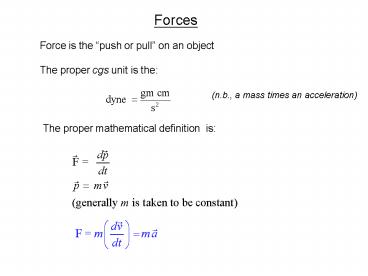Forces - PowerPoint PPT Presentation
1 / 47
Title:
Forces
Description:
speed of an object or the direction in which it. is going. ... perihelion and Mars at the aphelion. The major axis of this ellipse is. 1.0 1.52 = 2.52 AU. ... – PowerPoint PPT presentation
Number of Views:26
Avg rating:3.0/5.0
Title: Forces
1
Forces
Force is the push or pull on an objectThe
proper cgs unit is the
(n.b., a mass times an acceleration)
The proper mathematical definition is
2
So a force is required to change either the
speed of an object or the direction in which
it is going.Note that a force may also be
required to balanceanother force even when
nothing is moving. For example a block setting on
a table is pulled downwards by gravity but
supported by the table.
Examples Tennis ball hit by a racket retaining
constant speed Book setting on a table Planets
in orbits electrons in atoms, etc.
3
(No Transcript)
4
Newtons First
Figure from Nick Strobels site
5
Newtons Second
Figure from Nick Strobels site
6
Newtons Third
Figure from Nick Strobels site
7
(No Transcript)
8
(No Transcript)
9
At a fundamental level a force isnt just
something that happens to particles. It is
an interaction communicated between them.
The communication occurs by virtue of an
exchange particle. Imagine two basketball
players on ice skates throwing a basketball back
and forth. Eventually they will begin to move
apart. Attractive forces do not have such a
clear analogy.
10
In the Standard Model the Universe contains
4 fundamental forces
These forces interact with quarks, leptons, and
bosons in various ways.
11
(No Transcript)
12
(No Transcript)
13
(No Transcript)
14
(No Transcript)
15
(No Transcript)
16
Gravity
Figure from Nick Strobels electronic text. See
his website.
For spherically symmetric objects, gravity acts
as if all the mass were concentrated at the
center of the object.
17
(No Transcript)
18
(No Transcript)
19
Tides
The moon pulls on all parts of the Earth. It
pulls strongest on the part that is closest,
less on the center, and least of all on the far
side. Subtracting the force at the center of
mass from all components leads to a bulge in the
oceans both on the near and far side of the
Earth.
20
(No Transcript)
21
Centrifugal Force
y
q
x
(directed along r.)
22
(No Transcript)
23
(No Transcript)
24
Keplers First Law
The orbit of a planet around the sun is an
ellipse with the sun at one focus of the ellipse.
The equation for an ellipse
25
Keplers Second Law
A line connecting the orbiting both with one
focus of the ellipse (e.g., the sun) sweeps out
equal areas in equal times.
26
Keplers Third Law
The squares of the periods of the planets are
proportional to the cubes of their semi-major
axes
27
(No Transcript)
28
(No Transcript)
29
(No Transcript)
30
Hohmann Orbit
Image from Nick Strobels website
A fuel-efficient way to travel from here to Mars.
Launch when the Earth is closest to the sun
Launch at 1 AU in direction of Earths motion.
Accelerate into an elliptical orbit with Earth at
the perihelion and Mars at the aphelion. The
major axis of this ellipse is 1.0 1.52 2.52
AU. The semi-major axis is 1.26 AU. The orbital
period is thus 1.263/2 1.41 years and the
journey takes 0.71 years.
31
(No Transcript)
32
(No Transcript)
33
(No Transcript)
34
(No Transcript)
35
(No Transcript)
36
(No Transcript)
37
(No Transcript)
38
(No Transcript)
39
(No Transcript)
40
(No Transcript)
41
(No Transcript)
42
What is Dark Matter?
Anything with a large mass to light ratio
Baryonic dark matter
- White dwarfs
- Black holes (large and small)
- Neutron stars
- Brown dwarfs and planets
- Cold gas
But Big Bang nucleosynthesis limits the amount
of baryonic mass.
43
(No Transcript)
44
(No Transcript)
45
(No Transcript)
46
What is Dark Matter?
Anything with a large mass to light ratio
Non-baryonic dark matter
- Massive neutrinos
- Axions (particle that might be needed to
understand absence of CP
violation in the strong interaction) - Photinos, gravitinos, ....
- WIMPs
- unknown...
In general, particles that have mass but little
else
47
(No Transcript)































